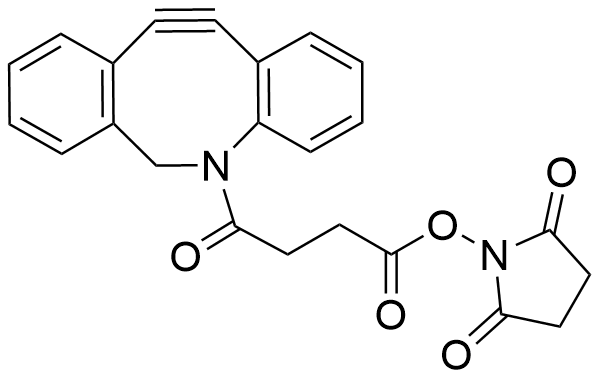DBCO-NHS Ester
DBCO-NHS Ester, also known as ADIBO-NHS Ester or DIBAC-NHS Ester, is an amine-reactive building block used for modification of amine-containing molecule in organic media. It reacts with primary amines (e.g., side chain of lysine residues or aminosilane-coated surfaces) at neutral or slightly basic pH to form covalent bonds. Short spacer arm adds minimal mass to modified molecules (228.3 daltons).
This product is not recommended for labeling of proteins or any other biopolymers in aqueous buffers due to poor aqueous solubility.

1. Campbell-Verduyn, L.S., et al. (2011). Strain-promoted copper-free “click” chemistry for 18F radiolabeling of bombesin. Angew Chem Int Ed., 50(47), 11117-20. [PubMed]
2. Meyer, A.M., et al. (2020). Programmable Assembly of Iron Oxide Nanoparticles Using DNA Origami. Nano Lett., 20(4), 2799-805. [PubMed]
3. Saikatr, M., et al. (2015). A Three-Arm Scaffold Carrying Affinity Molecules for Multiplex Recognition Imaging by Atomic Force Microscopy: The Synthesis, Attachment to Silicon Tips, and Detection of Proteins. J. Am. Chem. Soc., 137(23), 7415-25. [PubMed]
4. Christie, S.M., et al. (2020). Covalently Immobilizing Interferon-γ Drives Filopodia Production through Specific Receptor–Ligand Interactions Independently of Canonical Downstream Signaling. Bioconjugate Chem. 2020, 31, 5, 1362–1369, 31(5), 1362-69. [PubMed]
5. Reed, S.A., et al. (2020). Efficient Sortase-Mediated Ligation Using a Common C-Terminal Fusion Tag. Bioconjugate Chem. 2020, 31, 5, 1362–1369, 31(5), 1463-73. [PubMed]
6. Tao, W.A., et al. (2019). Identification and Quantification of Newly Synthesized Proteins Using Mass Spectrometry‐Based Chemical Proteomics. Mass Spectrometry‐Based Chemical Proteomics. [PubMed]
Abs/Em Maxima: 346/445 nmExtinction Coefficient: 19,000Spectrally Similar Dyes: Alexa Fluor? 350, CF? 350, DyLight 350, AMCAAZDye? 350 is a blue-fluorescent azide-activated probe that reacts with terminal alkynes via a copper-catalyzed click react…
Abs/Em Maxima: 402/424 nmExtinction Coefficient: 35,000Flow Cytometry Laser Line: 405 nmMicroscopy Laser Line: 405 nmSpectrally Similar Dyes: Alexa Fluor? 405, CF? 405, Cascade Blue?, DyLight? 405AZDye? 405 Azide is a water-soluble, pH-insensiti…
Abs/Em Maxima: 346/445 nmExtinction Coefficient: 19,000Spectrally Similar Dyes: Alexa Fluor? 350, CF? 350, DyLight 350, AMCAAZDye? 350 Alkyne (Alexa Fluor? 350 Alkyne equivalent) is a blue-fluorescent, alkyne-activated probe that reacts with azid…
Abs/Em Maxima: 430/537 nmExtinction Coefficient: 15,000Spectrally Similar Dyes: Alexa Fluor? 430, CF? 430AZDye? 430 Azide is a water-soluble, green-fluorescent azide-activated probe that reacts with terminal alkynes via a copper-catalyzed click re…
Abs/Em Maxima: 346/445 nmExtinction Coefficient: 19,000Spectrally Similar Dyes: Alexa Fluor? 350, CF? 350, DyLight 350, AMCAAZDye? 350 DBCO reacts with azides via a copper-free “click chemistry” reaction to form a stable triazole and does not re…
Abs/Em Maxima: 402/424 nmExtinction Coefficient: 35,000Flow Cytometry Laser Line: 405 nmMicroscopy Laser Line: 405 nmSpectrally Similar Dyes: Alexa Fluor? 405, CF? 405, Cascade Blue?, DyLight? 405AZDye? 405 Alkyne reacts with azides via a copper…
Abs/Em Maxima: 494/517 nmExtinction Coefficient: 73.000Flow Cytometry Laser Line: 488 nmMicroscopy Laser Line: 488 nmSpectrally Similar Dyes: Fluorescein, Alexa Fluor? 488, CF? 488A, DyLight? 488, Atto? 488AZDye? 488 Azide (Alexa Fluor? 488 Azi…
Abs/Em Maxima: 402/424 nmExtinction Coefficient: 35,000Flow Cytometry Laser Line: 405 nmMicroscopy Laser Line: 405 nmSpectrally Similar Dyes: Alexa Fluor? 405, CF? 405, Cascade Blue?, DyLight? 405ZDye? 405 DBCO reacts with azides via a copper-fr…

